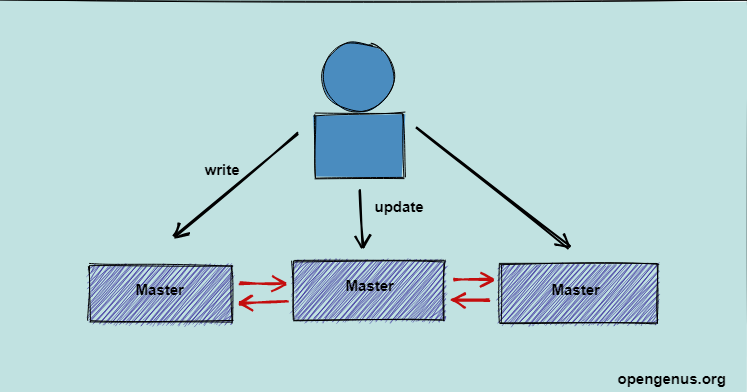
Open-Source Internship opportunity by OpenGenus for programmers. Apply now.
In this article at OpenGenus, let's understand Multi Master Replication and how it ensures data consistency in distributed systems. But first, let's understand all the basic terms related to this concept.
What is a Distributed System?
Imagine that there is a team of superheros, each having their own superpower, who are working together to save the world. Instead of relying on a single superhero, they all work together to defeat the enemy more efficiently. A distributed system is similar to this in the sense that just as each superhero has their own specific superpowers, each computer in a distributed system has its own tasks and responsibilities. Each computer communicates and coordinates with the other computers to get a task done faster and efficiently. If one computer breaks down or faces an issue, the others step up to continue the task, just like superheros. In this way, in distributed systems, tasks can be completed more quickly. Now,
What is Data Consistency and how is it connected to Distributed systems?
Lets stick with the superhero analogy. Data consistency means accuracy and reliability of information in the superhero team or here the network of computers. Imagine the superheros sharing important updates to defeat the enemy. In distributed systems, data consistency means that all the computers in the system have the same updated information. If data consistency is not maintained, its like some superheros having outdated information causing inefficiency. So, in a distributed system, ensuring data consistency is crucial for coordination among the computers, just like superheroes need accurate and consistent information to save the world.
Now that we have covered the basic terms, let's understand:
What is Multi Master Replication?
Multi Master Replication is a method that allows simultaneous updates across multiple nodes, such that each node has the ability to read and write data thus enabling data consistency across distributed systems. Let's explain this with our superhero analogy. In our team of superheros, each member has the power to make important decisions and take actions independently thus allowing multiple members to work together on different parts of a mission. Decisions taken by one superhero are communicated to other superheros. This ensures that all the superheros have the same information. This way, distributing work and increasing efficiency becomes easier.

Now that we know what multi master replication is, let's see,
Advantages of Multi Master Replication
-
High Availability: With multi master replication, multiple nodes can read and write data, reducing the risk of downtime. If one node fails, others can continue to perform tasks, ensuring high availability of a system.
-
Scalability: The load distribution across multiple nodes, enables the system to handle increased traffic and data volume. As the system grows, additional nodes can be added to scale to improve performance of the system.
-
Data Locality: With multiple copies of data across different nodes, data can be stored closer to the users or applications that need it. This reduces network latency and improves response times, enhancing overall system performance.
Multi Master Replication vs Alternatives
Although multi master replication offers several advantages in distributed systems, it's important to consider alternative methods to achieve data consistency. Let's compare multi master replication with alternatives like single master replication and leaderless replication.
-
Single Master Replication: In this method, there is a master node that handles all write operations, while other nodes act as slaves and only handle read operations. This approach ensures data consistency by centralising the responsibility of updates to a single node. However, in this method there is a single point of failure. If the master node experiences downtime, the system's overall availability can be affected.
-
Leaderless Replication: In this method, there is no master node. All nodes are equal and capable of handling both read and write operations. Each node independently processes updates and shares them with other nodes. This approach offers high availability as there is no single point of failure. However, ensuring data consistency can become difficult as conflicts may arise when multiple nodes attempt to update the same data simultaneously. It is different from multi master replication in terms of coordination of updates. In multi master replication, updates are synced among multiple master nodes, while in leaderless replication, each node independently handles updates.
Compared to these two alternatives, multi master replication provides a balance between data consistency and availability.
In conclusion, multi master replication allows for achieving data consistency in distributed systems. By allowing multiple nodes to independently update data, it ensures that all copies of the data are consistent, even when failures occur. Due to high availability, scalability and data locality, multi master replication has become a valuable technique in building efficient distributed systems. By understanding this concept, we can design distributed systems that provide consistent data, enabling apps to operate seamlessly in distributed environments.
